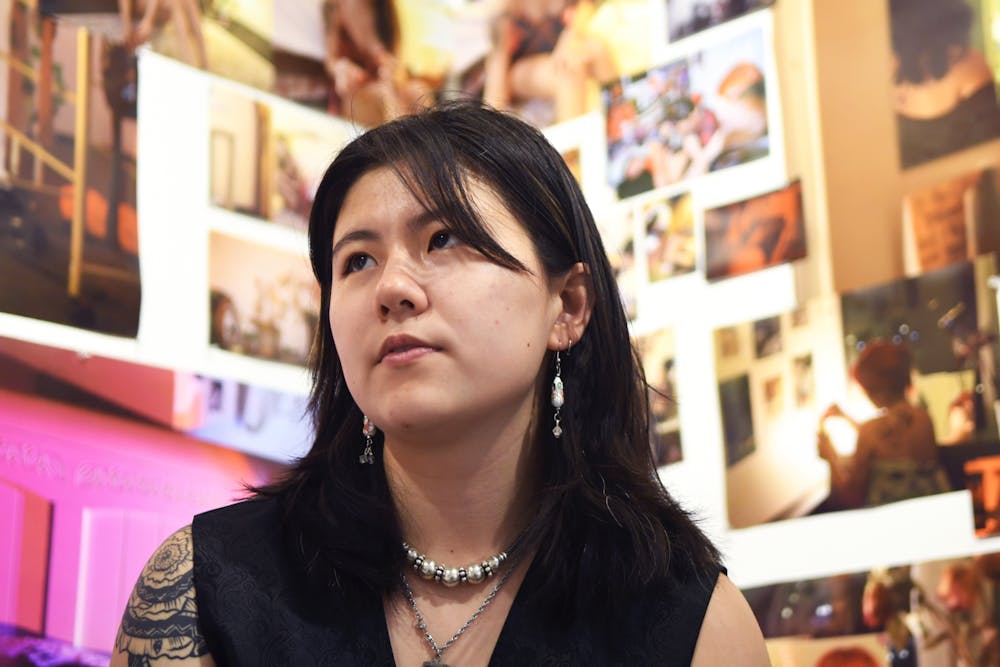Butterflies, tigers, a pair of crying eyes, a blossoming branch—if you can imagine it, Iza Hu (C '23) can design and tattoo it.
The first step is scheduling an appointment on Iza’s Instagram. Iza makes a point of holding appointments in the client’s dorm, both to make the receiver of the tattoo feel more comfortable, and because the details of a room—photographs, furniture, decorations—provide a window into someone’s life. This intimate understanding of the other person is essential because the art of tattooing, while a source of income for Iza, goes far beyond the transactional.The sessions last at least an hour, often longer. Sometimes first–timers are afraid of the pain, so Iza starts by drawing a tiny line and asking how it feels. It’s never as bad as people think it will be.
In such an intimate setting, Iza has the opportunity to really connect with the other person. She always asks two questions to start the conversation: “What is the meaning behind the tattoo? Are your parents okay with it?”
The people Iza meets are often receiving a tattoo for the first time, embracing the freedom of leaving home. “It’s something special to be a part of that moment,” she says. “Because it is rebellious.”
It is all too familiar to Iza. “My mom has always told me, ‘If you get a tattoo, I’ll bite it off of you,’” Iza says. Growing up, she knew she was good with her hands. Iza was drawn to art from a young age, but her parents, who both work in the medical field, urged her to apply her skills to plastic surgery.“Tattooing was just never an option on the table. Ever,” she says.
Upon arriving at Penn, Iza took a few math and science courses and quickly realized that the medical path was not for her. With her newfound independence, she switched to a design major. Back home in Texas, her parents, especially her mom, made it clear how heavily they disapproved of tattoos—but Iza has always been rebellious in nature. “Those statements made me want it more,” she says.
The summer going into her junior year, she bought her first tattoo machine and began picking up skills from YouTube. Iza was entirely self–taught, fueled by the conviction that she could do better than the people she watched on the TV show Ink Master. She practiced on orange peels and pig ears—materials that most closely mimicked the feeling of human skin. “At some point it clicked to me that tattoos are just art on the body,” she says.
Iza designed most of the tattoos on her own body. The first one she ever received depicts the Creation of Adam, the famous image of two hands reaching out towards each other—with a slight twist. “I didn’t want men or God on my body,” she says. “They’re actually my hands.”
All of her tattoos are intensely personal, from the double–headed snake on her collarbone that symbolizes indecision to the Chinese character on her chest, which says “art” in her mother’s handwriting. Iza explained that tattoo the last time she spoke to Street, in 2021, noting that her mother didn’t yet know about it.
However, in the following year, mother discovered Iza’s tattoos by accident; Iza was scratching her shoulder and revealed a tattoo she had previously kept hidden. The true shock came when she found out her daughter wanted to become a professional tattoo artist. “She cried,” Iza recalls. “I get it. You have this path you want your child to go on and they just stray so far from that.”
Iza committed to her passion, even in the face of criticism, and over time her mother has slowly embraced her daughter’s path. When she needs gloves and medical wipes for her equipment, her mother takes some from the hospital where she works to give to her daughter. When Iza completes a tattoo, she sends a picture to her mother for critique.
Iza’s step toward financial independence through her bookings has been especially important for her mother’s acknowledgment. “She just sees me as an adult now,” Iza notes.
Iza’s experience with hidden tattoos inspired her senior thesis project, entitled body is canvas. It focuses on “illegal tattoos”—body art that defies family and cultural expectations. Photographs from the project, currently on display in Charles Addams Fine Arts Gallery, cover two walls: the process of tattooing made vivid on the bodies of herself and her friends, from the initial sketch to the final product.
On a nearby bench, two binders showcase Iza’s designs in greater detail: a motorcycle merged with the head of a dragon, spiders and scorpions with jewels dangling from their pincers, flashes representing the animals of the Chinese zodiac. Dragons are a recurring theme, as well as references to her Texas background in the form of cowboys and skulls.
This summer, Iza will continue honing her style and skills as an apprentice to Omkara Tattoo. The shop aligns closely with her interests; it specializes in Asian designs and will give Iza the chance to practice larger pieces. Plus, Iza believes she would have discovered tattooing no matter which school she attended. Yet the fact that she developed this interest at Penn makes it particularly special to her. The university’s pre–professional environment makes many students feel like creative activities should be a side hobby, not a career. Amidst the pursuit of high–paying jobs at high–profile companies, Iza created her own path. “I’m proud that I’ve found this calling here,” she says.
Reflecting on what she loves about tattooing, Iza points out that people often view tattoos as permanent fixtures on the body. She considers them temporary. While other forms of art such as photography and paintings will outlive her, tattoos only last as long as the person they cover. The idea is perhaps morbid, but it’s one she keeps returning to.
“My art dies with the canvas,” Iza says. “Eventually it will be gone. I think it’s a beautiful concept.”







